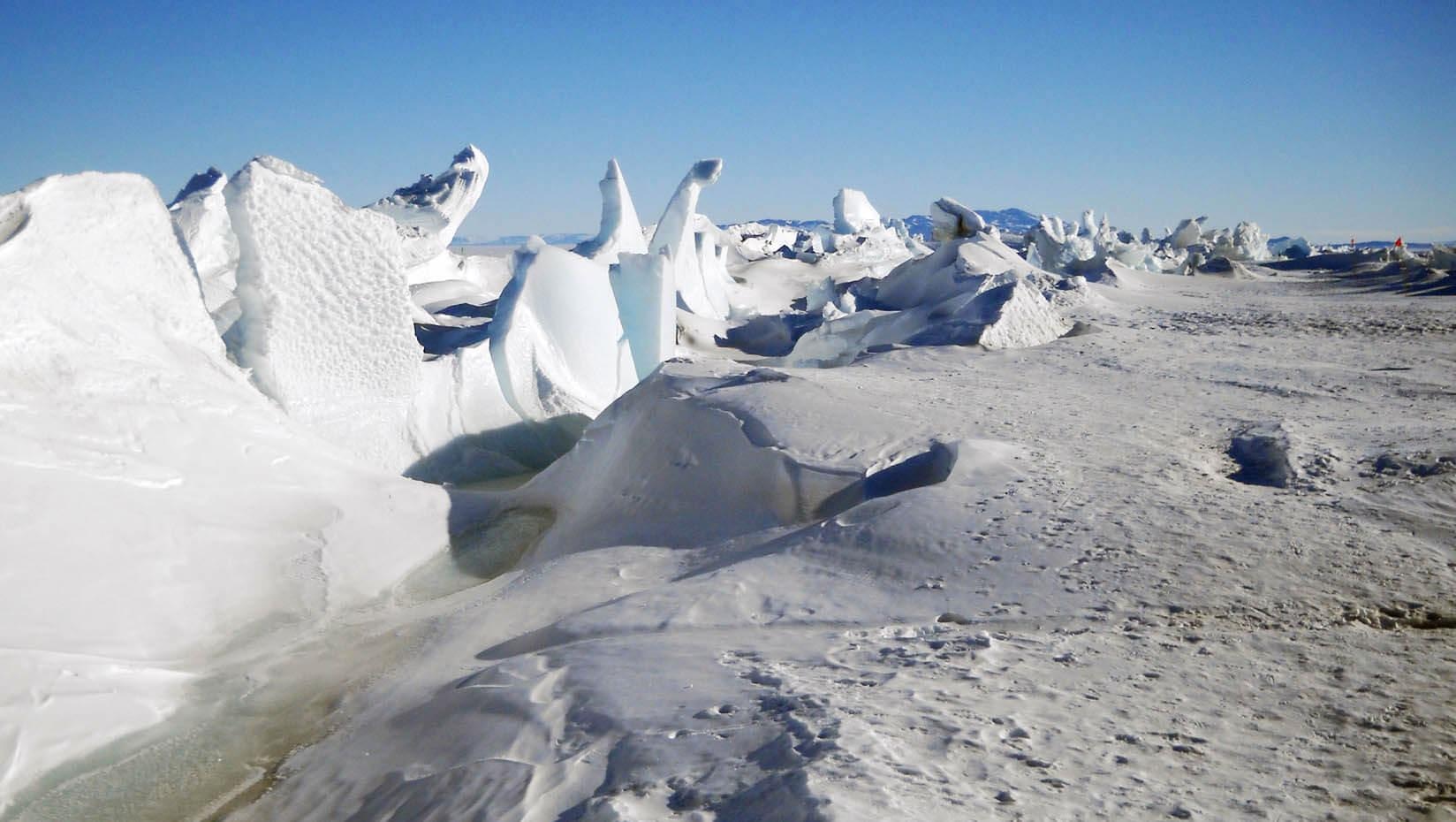May 6 2021
According to a new study, headed by the University of Maine, sea ice cover formed in the Southern Hemisphere is highly variable, from winter to summer periods and from one millennium to the next. On the whole, sea ice has been rising for around 10,000 years but with certain exceptions to this pattern.
 Sea ice pressure ridge off the Antarctic coast. Image Credit: University of Maine.
Sea ice pressure ridge off the Antarctic coast. Image Credit: University of Maine.
Dominic Winski, a research assistant professor from the Climate Change Institute at the University of Maine, led a study that investigated the chemistry of a 54,000-year-old South Pole ice core and subsequently revealed new data about the variability of sea ice over the centuries, specifically across seasons, in the Southern Hemisphere.
The Southern Ocean faces the world’s largest seasonal disparity in sea ice cover, with Antarctica covered by 18.5 million km2 of sea ice during the wintertime and just 3.1 million km2 of ice during the summertime.
The team believes that this seasonal difference in sea ice has a major impact on global and regional climate, but for years, researchers were not fully aware of the extent of variations in sea ice in the Southern Hemisphere before 1979.
When a research team recently recovered the oldest and deepest ice core from the South Pole and examined it, Winski grabbed this chance to find out more about seasonal changes and the variations in sea ice in the Southern Hemisphere across the Holocene—that is, the last 11,400 years.
Winski and his collaborators decided to study the ice core chemistry, specifically its concentrations of sea salt, to understand more about the changes in sea ice in this region.
Karl Kreutz, a professor of Earth and climate sciences from the University of Maine, and scientists from Dartmouth College, South Dakota State University, the University of Washington, and the University of Colorado Boulder were involved in the study. An article describing the team’s results was published in the Geophysical Research Letters journal.
The researchers exploited the large seasonal changes in the Southern Ocean climate to produce a sea ice record that showed separate winter and summer variability. They subsequently merged this data with an advanced atmospheric chemistry model to connect the measurements of ice core with the variability of sea ice.
The outcome was a comprehensive record of Southern Ocean sea ice demonstrating significant changes, particularly during wintertime sea ice.
Salt concentrations in the ice core, which are vulnerable to sea ice variability, have increased in the last 11,400 years, specifically in the last 8,000–10,000 years, and this corresponded with an increase in ice cover.
Concentrations in winter sea salt, which mainly emerged from salty snow on top of sea ice, particularly increased over the centuries, revealing an overall increase in sea ice during wintertime. This trend was observed elsewhere in Antarctica, which made the researchers conceptualize an Antarctic-wide increase in sea ice during this time.
One of the most important and challenging goals in our field is to produce detailed reconstructions of sea ice variability. The exceptional detail of the South Pole Ice Core combined with results from our modeling team gives us a powerful dataset for understanding Antarctic sea ice.
Dominic Winski, Research Assistant Professor, Climate Change Institute, University of Maine
Both Winski and Kreutz helped recover the 54,000-year-old ice core, which they had used in their new project during a couple of expeditions from 2014 to 2016.
Called SPICEcore (South Pole Ice Core), the study included investigators from 18 institutions with a goal to build an archive of climate conditions in East Antarctica, such as variations in atmospheric chemistry, biogeochemistry, and climate, during the past 54,000 years.
The South Pole Ice Core (SPICEcore) is the most precisely dated climate record in this region of Antarctica. We put in a tremendous amount of effort to collect individual chemistry samples for every centimeter of ice.
Dominic Winski, Research Assistant Professor, Climate Change Institute, University of Maine
“In total, we had to analyze the chemistry of over 100,000 vials of melted ice, but the effort paid off since now we have the rare opportunity to investigate seasonal changes in the Antarctic environment for over 10,000 years,” added Winski.
Although the Southern Hemisphere underwent an overall increase in ice cover across the Holocene, scientists observed a sudden drop in the concentrations of sea salt in the ice core dating back to 5,000–6,000 years ago.
The researchers believe that the drop in salt concentrations denotes a decrease in ice cover that was specific to the South Atlantic during that period, a finding substantiated by a previous study.
On the other hand, ice cover in the North Atlantic was more widespread at that time, which according to the team indicates “a linked and opposing sea ice signal in the North and South Atlantic most likely due to changing ocean circulation.”
This trend of conflicting South and North Atlantic climate was popular during the sudden climatic change of colder periods deep in the past. The study results may offer a clue that the same processes could still be applicable under contemporary conditions.
Considering seasonal changes when investigating variations in sea ice across an unlimited number of years helps investigators to fully explain the previous Antarctic climate and also allows them to interpret the processes and mechanisms that drive climate change.
Huge changes in sea ice can occur very rapidly, leading to ramifications for climate worldwide. We still don’t entirely understand the forces influencing sea ice variability, which is why detailed climate information from the past is absolutely critical.
Dominic Winski, Research Assistant Professor, Climate Change Institute, University of Maine
Journal Reference:
Winski, D. A., et al. (2021) Seasonally Resolved Holocene Sea Ice Variability Inferred From South Pole Ice Core Chemistry. Geophysical Research Letters. doi.org/10.1029/2020GL091602.